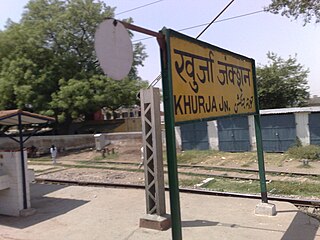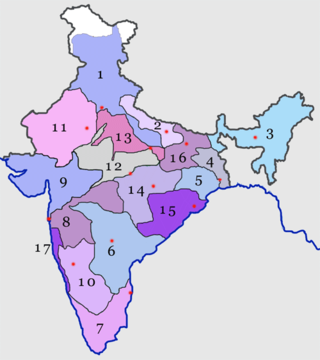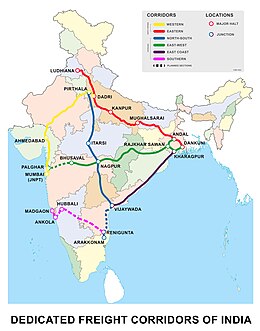
Rail transport in India consists of primarily of passenger and freight shipments along an integrated rail network. Indian Railways (IR), a statutory body under the ownership of the Ministry of Railways of the Government of India, operates India's national railway system. It is the primary owner and operator of rail operations throughout the country including suburban rail in major metros.

Indian Railways (IR) is a statutory body under the ownership of the Ministry of Railways of the Government of India that operates India's national railway system. As of 2023, it manages the fourth largest national railway system by size with a running track length of 104,647 km (65,025 mi) and route length of 68,426 km (42,518 mi) of which 60,451 km (37,563 mi) is electrified. With more than 1.2 million employees, it is the world's ninth-largest employer and India's second largest employer.

Grand Chord is part of the Howrah–Gaya–Delhi line and Howrah–Prayagraj–Mumbai line. It acts as a link between Sitarampur, (Asansol), and Pt. Deen Dayal Upadhyay Junction,, previously known as Mughalsarai Junction, and covers a stretch of 450.7 km (280.1 mi). The Coal India Corridor line that branches off from Dhanbad Junction and rejoins the Grand Chord at Son Nagar Junction is another major coal loading hub. It is a fully electrified, quadruple line section from Pt. Deen Dayal Upadhyay to Son Nagar and double line section from Son Nagar to Sitarampur. There are plans to triple the lines from Son Nagar to Dhanbad to accommodate the increasing traffic.. The entire line lies under the jurisdiction of three divisions, Mughalsarai railway division, Dhanbad railway division and Asansol railway division. The Grand chord section is the lifeline of the country, 2nd busiest railway section of India after Ghaziabad, Uttar Pradesh to Pt. Deen Dayal Upadhyay Junction, Uttar Pradesh Main Line section, on which coal, steel and other important goods are moved from Eastern section to Western and Northern sections of the country. In the down direction, the traffic consists of mostly food grains, fertilizers and empty wagons for coal loading in the Jharkhand and West Bengal coal fields. Pt. Deen Dayal Upadhyay Junction is a transit division and the main objective is to maintain mobility of high density traffic. The present capacity of the Grand Chord is being optimally utilized. Traversing through Chota Nagpur Plateau of Jharkhand as well as parts of the fertile Gangetic plains of Bihar, the Grand Chord covers a stretch of 450.7 km (280.1 mi). The Grand Chord is renowned for its remarkable controlling of passenger traffic, despite being burdened with freight traffic.

The Indian locomotive class WAG-9 is a class of 25 kV AC electric locomotives that was developed in 1995 by ABB for Indian Railways. The model name stands for broad gauge (W), AC Current (A), Goods traffic (G), 9th generation (9) locomotive. They entered service in 1996. A total of 5140 WAG-9 have been built at Chittaranjan Locomotive Works (CLW), with more units being built at Banaras Locomotive Works (BLW), Bharat Heavy Electricals Limited (BHEL) and Patiala Locomotive Works (PLW). It was the most powerful freight locomotive of its fleet until the formal introduction of the WAG-12.

Indian Railways operates India's railway system and comes under the purview of the Ministry of Railways of Government of India. As of 2023, it maintains over 108,706 km (67,547 mi) of tracks and operates over 13,000 trains daily. According to the Ministry of Railways, a route capable of supporting trains operating at more than 160 km/h (100 mph) is considered as a higher speed or semi-high speed rail line.

Urban rail transit in India plays an important role in intracity transportation in the major cities which are highly populated. It consists of rapid transit, suburban rail, monorail, and tram systems.

India has a system of express trains, operated by Indian Railways which comes under the purview of the Ministry of Railways of Government of India. As of 2023, it maintains over 108,706 km (67,547 mi) of tracks and operates nearly 3,000 express trains daily. According to the Ministry of Railways, express trains travel faster and have limited stops than ordinary passenger trains. Any passenger train with an average speed higher than 55 km/h (34 mph) is considered super-fast.

Rewari Junction railway station is a major railway station of the Indian Railways serving the city of Rewari in the Indian state of Haryana. It is in the Jaipur Division of the North Western Railway zone and lies on the Delhi–Ajmer–Ahmedabad route. Six railway lines branch out from this railway station. The seventh railway line from Rewari will be laid as a dedicated freight railway line as a part of the Western Dedicated Freight Corridor.

The Western Dedicated Freight Corridor or Western DFC is a 1,506 km long, under-construction 1,676 mm freight corridor in India. It will connect Dadri in Uttar Pradesh with the Jawaharlal Nehru Port in Navi Mumbai, Raigad District, Maharashtra. The corridor is being built by the Dedicated Freight Corridor Corporation of India Limited (DFCCIL), a public-sector unit (PSU) under the Ministry of Railways and would be electrified with double-line operation. The Western DFC entails a new single-line branch from Prithla in Palwal district to Tughlakabad in Delhi, running parallel to the existing New Delhi–Faridabad–Palwal railway line.

Eastern Dedicated Freight Corridor or Eastern DFC is a broad gauge freight corridor in India. The railway will run between Ludhiana in Punjab and Dankuni in West Bengal via Meerut and Khurja in Uttar Pradesh. This railway line is one of the multiple freight corridors being constructed by the Dedicated Freight Corridor Corporation of India (DFCCIL), a public-sector unit (PSU) under the Ministry of Railways.

Khurja Junction railway station is a railway station at Khurja in Bulandshahr district on the North Central Railway network. It is an important station on the New Delhi–Aligarh–Kanpur main line.

The Indian locomotive class WAG-12B is a class of 25 kV AC electric locomotives that was developed in 2017 by Alstom with technological collaboration with Indian Railways. The model name stands for wide gauge(W), Alternating Current (A), Goods traffic (G) locomotive-12 . They entered trial service in 2019. A total of 410 WAG-12B have been built at Electric Locomotive Factory, Madhepura, Bihar, India.
The Indian Government is undertaking several initiatives to upgrade its aging railway infrastructure and enhance its quality of service. The Railway Ministry has announced plans to invest ₹5,400,000 crore to upgrade the railways by 2030. Upgrades include 100% electrification of railways, upgrading existing lines with more facilities and higher speeds, expansion of new lines, upgrading railway stations, introducing and eventually developing a large high-speed train network interconnecting major cities in different parts of India and development of various dedicated freight corridors to cut down cargo costs within the country.
Dadri railway station is a railway station serving the city of Dadri in Gautam Buddh Nagar district, Uttar Pradesh, India, on the Delhi–Aligarh–Kanpur section, around 50 km east of Delhi. Its station code in Indian Railways terminology is DER. Dadri is a wayside station at which only a few commuter trains stop. The station consists of four platforms which are not well sheltered and lack most facilities including sanitation.
The North-South Dedicated Freight Corridor or North-South DFC is a proposed freight specific railway connecting New Delhi and Chennai. The approximate length of the corridor is 2,343 km with 43 proposed stations. Ministry of Railways has assigned Dedicated Freight Corridor Corporation of India (DFCCIL) to undertake Preliminary Engineering & Traffic Survey (PETS) for four additional corridors:

Rail transport in the state of Haryana, India, is conducted by five rail divisions in three zones: the North Western Railway zone, Northern Railway zone, and North Central Railway zone. The Diamond Quadrilateral high-speed rail network, Eastern Dedicated Freight Corridor, and Western Dedicated Freight Corridor pass through Haryana.

Vande Bharat Express is a medium-distance superfast express service operated by Indian Railways. It is a reserved, air-conditioned chair car service connecting cities that are less than 800 km (500 mi) apart or take less than ten hours to travel with existing services. The train entered commercial service on 15 February 2019.

Haryana Orbital Rail Corridor (HORC), with target completion by 31 March 2025, is an under construction twin-track 121.7-kilometre (75.6 mi)-km long, 160 km per hour high-speed, railway project in Haryana state of India, which will run around along the Western Peripheral Expressway (WPE) on the western side of Delhi.
Delhi–Ahmedabad High Speed Rail Corridor is an approved high-speed rail line connecting India's capital Delhi with the city of Ahmedabad. When completed, it will be India's second high-speed rail line. It is also said to be an extension of Mumbai–Ahmedabad HSR corridor.






















